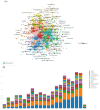Novel Tissue Engineering Scaffolds in the Treatment of Spinal Cord Injury-A Bibliometric Study
- PMID: 40281707
- PMCID: PMC12025192
- DOI: 10.3390/bioengineering12040347
Novel Tissue Engineering Scaffolds in the Treatment of Spinal Cord Injury-A Bibliometric Study
Abstract
Objective: Because of the evolving nature of tissue engineering scaffolds in the treatment of spinal cord injury (SCI), the current study was carried out to evaluate the research productivity of tissue engineering scaffolds in the treatment of SCI.
Methods: Studies published from 2000 to 2025 were retrieved from the Web of Science core collection with topics of spinal cord injury and tissue engineering scaffolds. The data were analyzed and visualized using the VOSviewer network analysis software.
Results: Among 1542 articles analyzed, annual publications surged from 2000 to 2019, stabilizing thereafter. The U.S., China, and Canada led in productivity, with Northwestern University and the Biomaterials journal being top contributors. Keyword analysis revealed research hotspots such as functional recovery, axonal regeneration, stem cells, and hydrogels. Notably, hydrogels embedded with genetically engineered cells emerged as a pivotal trend, reflecting a shift toward biomimetic and combinatorial therapies. Collaboration networks highlighted intensified partnerships between Chinese and North American institutions, signaling global interdisciplinary efforts.
Conclusions: This study provides the first bibliometric roadmap for tissue engineering scaffolds in SCI, identifying key trends, influential entities, and underexplored areas. The rise in hydrogels and international collaborations underscores opportunities for targeted research. These findings guide researchers in prioritizing high-impact journals, fostering partnerships, and advancing novel scaffold designs to bridge translational gaps in SCI treatment.
Keywords: axonal regeneration; bibliographic study; cell transplantation; hydrogels; spinal cord injury; tissue engineering.
Conflict of interest statement
The authors declare no conflicts of interest.
Figures






Similar articles
-
Bibliometric analysis of stem cells for spinal cord injury: current status and emerging frontiers.Front Pharmacol. 2023 Jul 18;14:1235324. doi: 10.3389/fphar.2023.1235324. eCollection 2023. Front Pharmacol. 2023. PMID: 37533634 Free PMC article.
-
Knowledge domain and hotspots concerning photosensitive hydrogels for tissue engineering applications: A bibliometric and visualized analysis (1996-2022).Front Bioeng Biotechnol. 2022 Nov 14;10:1067111. doi: 10.3389/fbioe.2022.1067111. eCollection 2022. Front Bioeng Biotechnol. 2022. PMID: 36466359 Free PMC article.
-
A bibliometric analysis of the research hotspots and frontiers related to cell death in spinal cord injury.Front Neurol. 2024 Jan 5;14:1280908. doi: 10.3389/fneur.2023.1280908. eCollection 2023. Front Neurol. 2024. PMID: 38249747 Free PMC article.
-
Bibliometric analysis of research on gene expression in spinal cord injury.Front Mol Neurosci. 2022 Oct 31;15:1023692. doi: 10.3389/fnmol.2022.1023692. eCollection 2022. Front Mol Neurosci. 2022. PMID: 36385766 Free PMC article.
-
Research on stem cell therapy for spinal cord injury: a bibliometric and visual analysis from 2018-2023.Front Genet. 2024 Feb 6;15:1327216. doi: 10.3389/fgene.2024.1327216. eCollection 2024. Front Genet. 2024. PMID: 38380424 Free PMC article. Review.
References
-
- Yekaninejad M.S., Derakhshanrad N., Kazemi E., Derakhshanrad A., Saberi H. Influential factors for final neurorehabilitation outcome scores in patients with spinal cord injury: A longitudinal cohort study. J. Neurorestoratol. 2024;12:100117. doi: 10.1016/j.jnrt.2024.100117. - DOI
Grants and funding
LinkOut - more resources
Full Text Sources

